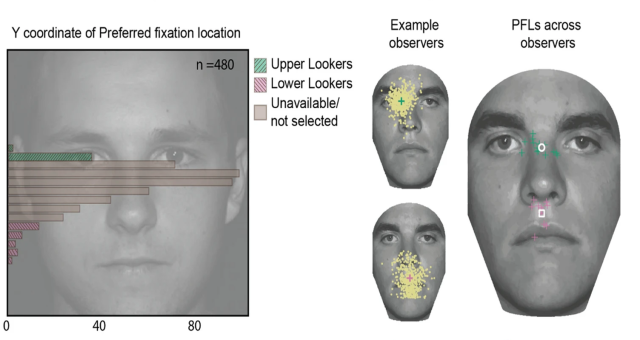New paper by Puneeth Chakravarthula uncovers different face neural codes for eye lookers vs. mouth lookers
Eye lookers and mouth lookers' brains process faces differently

When looking at faces, humans invariably move their eyes to a consistent preferred first fixation location on the face. While most people have the preferred fixation location just below the eyes, a minority have it between the nose-tip and mouth. Not much is known about whether these long-term differences in the preferred fixation location are associated with distinct neural representations of faces. To study this, Puneeth, used a gaze-contingent face adaptation aftereffect paradigm to test in two groups of observers.
The face adaptation aftereffect (FAE) is a well-known perceptual effect where prolonged viewing of a face can change the percept of a subsequently viewed face. The FAE is thought to occur due to visual adaptation, wherein neurons that code for the features of a stimulus become desensitized after prolonged exposure to the stimulus. Visual adaptation occurs throughout the visual hierarchy, from the retina to the extrastriate cortex. Further, the neurons become more tolerant to changes in low-level features such as retinal position as we move up the visual hierarchy. Relying on this notion, researchers often use the degree of tolerance of aftereffects to changes in spatial locations to identify the locus of the adaptation effect.
Building on this framework, Puneeth first screened over 400 observers to find distinct groups of eye and lower nose/mouth lookers. He then tested the FAE while requiring participants to maintain their gaze at either their own group’s mean preferred fixation location or that of the other group during adaptation and testing. He measured the face adaptation aftereffects when the adaptation and testing happened while participants maintained fixation at either the same or different locations on the face. Both groups showed equally strong adaptation effects when the adaptation and testing happened at the same fixation location. Crucially, only the upper (eye) lookers showed a partial transfer of the FAE across the two fixation locations, when adaptation occurred at the eyes. Lower (lower nose/mouth) lookers showed no spatial transfer of the FAE irrespective of the adaptation position. Given the classic finding that neural tuning is increasingly position invariant as one moves higher in the visual hierarchy, this result suggests that differences in the preferred fixation location are associated with distinct neural representations of faces.